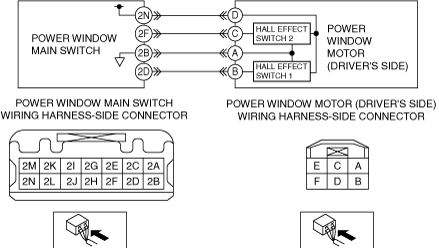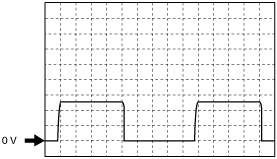|
1
|
VERIFY IF MALFUNCTION CAUSE IS OPERATION UNDER OPERATION PERMISSION CONDITION
• Perform the power window system initialization procedure.
• Does the driver-side door glass operate automatically using the power window main switch?
|
Yes
|
System is normal. (Tell the customer about power window system initialization procedure.)
|
|
No
|
Go to the next step.
|
|
2
|
POWER WINDOW MAIN SWITCH CONNECTOR INSPECTION
• Switch the ignition off.
• Disconnect the negative battery terminal.
• Disconnect the power window main switch connector.
• Inspect the connector engagement and connection condition and inspect the terminals for damage, deformation, corrosion, or disconnection.
• Is the connector normal?
|
Yes
|
Go to the next step.
|
|
No
|
Repair or replace the connector, then go to Step 10.
|
|
3
|
POWER WINDOW MOTOR CONNECTOR INSPECTION
• Disconnect the power window motor connector.
• Inspect the connector engagement and connection condition and inspect the terminals for damage, deformation, corrosion, or disconnection.
• Is the connector normal?
|
Yes
|
Go to the next step.
|
|
No
|
Repair or replace the connector, then go to Step 10.
|
|
4
|
POWER WINDOW MOTOR TERMINAL D INSPECTION
• Reconnect all the disconnected connectors.
• Connect the negative battery terminal.
• Measure the voltage at the power window motor terminal D (vehicle wiring harness side).
• Is the voltage B+?
|
Yes
|
Go to Step 6.
|
|
No
|
Go to the next step.
|
|
5
|
POWER WINDOW MAIN SWITCH TERMINAL 2N INSPECTION
• Measure the voltage at power window main switch terminal 2N (vehicle wiring harness side).
• Is the voltage B+?
|
Yes
|
Refer to the wiring diagram and verify if there is a common connector between power window main switch terminal 2N and power window motor terminal D.
If there is a common connector:
• Inspect the common connector and terminals for corrosion, damage, or disconnection and the common wiring harnesses for an open or short circuit to determine the malfunctioning location.
• Repair or replace the malfunctioning location.
If there is no common connector:
• Repair or replace the wiring harness which has an open or short circuit.
Go to Step 10.
|
|
No
|
Replace the power window main switch, then go to Step 10.
|
|
6
|
DETERMINE IF MALFUNCTION CAUSE IS POWER WINDOW MAIN SWITCH INTERNAL GROUND SYSTEM
• Disconnect the negative battery terminal.
• Inspect for continuity between power window motor terminal A (vehicle wiring harness side) and body ground.
• Is there continuity?
|
Yes
|
Go to Step 8.
|
|
No
|
Go to the next step.
|
|
7
|
VERIFY IF MALFUNCTION CAUSE IS OPEN CIRCUIT IN WIRING HARNESS BETWEEN POWER WINDOW MAIN SWITCH AND POWER WINDOW MOTOR
• Disconnect the power window main switch connector and power window motor connector.
• Inspect for continuity between the following terminals (vehicle wiring harness).
-
? Power window main switch terminal 2B and power window motor terminal A
• Is there continuity?
|
Yes
|
Replace the power window main switch, then go to Step 10.
|
|
No
|
Refer to the wiring diagram and verify if there is a common connector between power window main switch terminal 2B and power window motor terminal A.
If there is a common connector:
• Inspect the common connector and terminals for corrosion, damage, or disconnection and the common wiring harnesses for an open circuit to determine the malfunctioning location.
• Repair or replace the malfunctioning location.
If there is no common connector:
• Repair or replace the wiring harness which has an open circuit.
Go to Step 10.
|
|
8
|
POWER WINDOW MAIN SWITCH TERMINALS 2F AND 2D INSPECTION
• Reconnect all the disconnected connectors.
• Connect the negative battery terminal.
• Measure the pulse at power window main switch terminals 2F and 2D.
• Is the pulse normal?
|
Yes
|
Replace the power window main switch, then go to Step 10.
|
|
No
|
Go to the next step.
|
|
9
|
POWER WINDOW MOTOR TERMINALS B AND C INSPECTION
• Measure the pulse at power window motor terminals B and C.
• Is the pulse normal?
|
Yes
|
Refer to the wiring diagram and verify if there is a common connector between the following terminals.
• Power window main switch terminal 2D and power window motor terminal B
• Power window main switch terminal 2F and power window motor terminal C
If there is a common connector:
• Inspect the common connector and terminals for corrosion, damage, or disconnection and the common wiring harnesses for an open or short circuit to determine the malfunctioning location.
• Repair or replace the malfunctioning location.
If there is no common connector:
• Repair or replace the wiring harness which has an open or short circuit.
Go to the next step.
|
|
No
|
Replace the power window motor, then go to the next step.
|
|
10
|
VERIFY IF MALFUNCTION CAUSE IS CORRECTED
• Does the power window system operate normally?
|
Yes
|
Troubleshooting completed. (Explain the problem to the customer.)
|
|
No
|
Verify the malfunction symptom in the symptom troubleshooting chart and perform the other applicable malfunction diagnosis.
|

